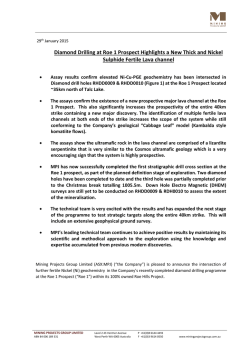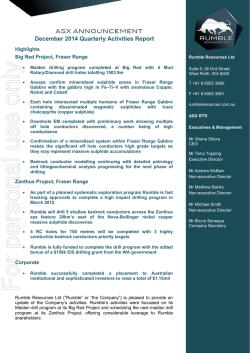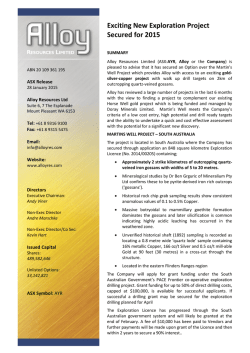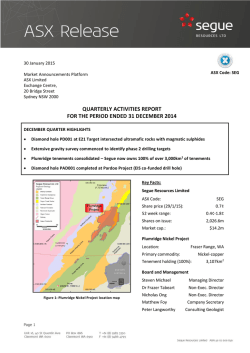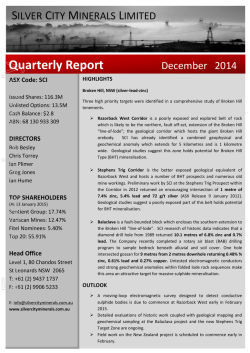
ASX RELEASE - Birimian Gold Limited
ASX RELEASE 2 February 2015 ASX : BGS HIGH POTENTIAL NEW EXPLORATION PERMIT GRANTED AT THE MASSIGUI GOLD PROJECT, MALI The emerging West African Gold Exploration Company Targeting multi-million ounce gold deposits in Mali HIGHLIGHTS and Liberia. Expanding gold inventory expands landholding at the Massigui Gold Project, Mali, to >750km2 at existing assets and via new project generation. Prospects. Chairman Kevin Joyce outstanding gold potential and represents an immediate drill target. Non-Executive Director Rupert Dearden / Richard Glass Historical drill intersection of 3m @ 18.1 g/t gold from 10m in very widely spaced, shallow drilling at the Sirikoro Prospect confirms Managing Director Investor Relations New “Batouba” permit (100% BGS) covers similar geological sequence and structures to gold mineralisation at Ntiola and Viper Winton Willesee Hugh Bresser Grant of new highly prospective exploration permit significantly Numerous untested gold anomalies in exploration pits and multiple gold-in-soil anomalies are yet to be subjected to bedrock drilling. Systematic mapping and geochemical sampling programs to commence in preparation for initial phase of drilling. MAGNUS Communication T: +61 8 6160 4903 E: [email protected] Suite 9, 5 Centro Ave, Subiaco WA 6008 PO Box 457 West Perth WA 6872 Birimian Gold Limited (ASX:BGS; “Birimian Gold” or the “Company”) is pleased to advise that a new exploration permit has been granted to the Company at the Massigui Gold Project in Mali. The highly prospective new permit area at “Batouba” is situated approximately 20km to the north west of the Company’s advanced Ntiola and Viper Prospects. This acquisition expands the landholding at the Massigui Gold Project to in excess of 750km2 (Figure 1). The Batouba permit covers 80km2 of similar gold bearing structures and host lithologies to those which contain shallow high grade gold mineralisation at the Company’s advanced Ntiola and Viper Prospects. P: +61 8 9286 3045 F: +61 8 9226 2027 E: [email protected] ABN 11 113 931 105 A comprehensive exploration database has been compiled for the new permit area. Analysis of this data has highlighted multiple zones which the Company believes display excellent potential for new gold discoveries. Birimian Gold Limited 2 February 2015 Figure 1. Birimian Gold’s Massigui Gold Project, Mali Batouba Permit The Batouba Authorization to Prospect (80km2) has been granted to Timbuktu Ressources SARL, a wholly owned Malian subsidiary of Birimian Gold Limited. The Company retains a 100% interest in the permit area. After the initial three month license period the Batouba Authorization to Prospect will convert to a Research Permit, which will be valid, subject to renewal, for a further eight years. Previous exploration work is summarized in the attached tables and figures. Of significant interest to the Company is the large scale, high tenor gold anomalous zone at the Sirikoro Prospect (Figure 2), where very wide spaced RC drilling conducted by the Japanese International Co-operation Agency (JICA) intersected high grade gold mineralisation, including 3m @ 18.1 g/t Au from 10m (MSRC03). The Sirikoro Prospect was initially identified as a broad gold-in-soil anomaly. A portion of this strike extensive (>4km long) anomaly was subsequently investigated by pit sampling and very broad 250m x 100m spaced shallow, vertical, reverse circulation (RC) drilling to a nominal set-depth of only 60m. Highly anomalous gold results from these initial programs confirm the gold potential of the Sirikoro Prospect area. The Company believes that the historical drill intersections and exploration pit anomalies at Sirikoro have not been adequately investigated by the drilling conducted to date, and there is excellent potential to discover new shallow gold resources at Sirikoro and in the broader Prospect area. A number of other prospects have been defined by soil sampling on the property (see inset, Figure 2). The anomalies are at an early stage of reconnaissance and have never been subjected to systematic bedrock drill testing. The Company will shortly commence field mapping and additional surface geochemical sampling to validate previous results and prioritise targets for systematic follow up drilling. Suite 9, 5 Centro Ave, Subiaco WA 6008 P.O. Box 457, West Perth WA 6872 Australia P: +61 8 9286 3045 F: +61 8 9226 2027 E: [email protected] www.birimiangold.com.au Birimian Gold Limited 2 February 2015 Figure 2. Sirikoro Prospect location plan. About Birimian Gold Limited Birimian Gold holds substantial interests in several highly prospective gold projects situated within the Birimian Gold Belt of West Africa; a gold rich region which has produced in excess of 250 million ounces of gold from large, low cost mines. The Company’s primary assets include the advanced Massigui Gold Project and Dankassa Gold Project in Southern Mali, and the Basawa Gold Project in Liberia. Following the discovery of the Ntiola Deposit at the Massigui Project, Birimian Gold continues to pursue a targeted exploration campaign over the greater Project area with the aim of identifying additional shallow gold resources amenable to open pit mining techniques to add to the total gold inventory. The Ntiola Deposit is located 25km from the world class Morila Gold Mine, operated by Randgold Resources. For further information please contact : Mr Kevin Joyce Managing Director (08) 9286 3045 [email protected] Suite 9, 5 Centro Ave, Subiaco WA 6008 P.O. Box 457, West Perth WA 6872 Australia P: +61 8 9286 3045 F: +61 8 9226 2027 E: [email protected] www.birimiangold.com.au Birimian Gold Limited 2 February 2015 Competent Persons Declaration The information in this announcement that relates to exploration results is based on information compiled by or under the supervision of Kevin Anthony Joyce. Mr Joyce is Managing Director of Birimian Gold Limited and a Member of the Australian Institute of Geoscientists. Mr Joyce has sufficient experience which is relevant to the style of mineralisation and type of deposit under consideration and the activity he is undertaking to qualify as a Competent Person as defined in the 2012 Edition of the “Australasian Code for Reporting of Exploration Results. Mr Joyce consents to the inclusion in the report of the matters based on his information in the form and context in which it appears. Suite 9, 5 Centro Ave, Subiaco WA 6008 P.O. Box 457, West Perth WA 6872 Australia P: +61 8 9286 3045 F: +61 8 9226 2027 E: [email protected] www.birimiangold.com.au Birimian Gold Limited 2 February 2015 Table 1. Summary of historical RC drill hole results within the Batouba Authorisation to Prospect. Hole_ID North East Dip Azm Hole Depth From To Width Au g/t MSRC01 1331342 708539 -90 0 60 3 4 1 0.58 MSRC03 1331470 708694 -90 0 60 10 13 3 18.10 MSRC04 1331534 708770 -90 0 60 3 4 1 0.67 and 53 56 3 0.47 and 59 60 1 1.43 MSRC06 1331663 708922 -90 0 60 12 13 1 0.75 MSRC10 1331920 709228 -90 0 60 40 41 1 0.60 MSRC14 1331726 708608 -90 0 60 21 22 1 0.63 34 37 3 0.78 and MSRC20 1332112 709067 -90 0 60 17 18 1 0.61 MSRC23 1331852 708371 -90 0 60 12 13 1 0.52 MSRC32 1331980 708134 -90 0 60 57 58 1 0.75 MSRC33 1332045 708210 -90 0 60 58 59 1 0.64 MSRC34 1332109 708287 -90 0 60 7 8 1 0.65 33 34 1 0.63 and 43 44 1 0.61 MSRC37 and 1332302 708517 -90 0 60 25 26 1 0.65 MSRC41 1332108 707897 -90 0 60 18 19 1 0.64 MSRC46 1332429 708281 -90 0 60 31 32 1 0.57 MSRC47 1332493 708355 -90 0 60 and 8 9 1 0.83 16 17 1 0.89 MSRC50 1332686 708586 -90 0 60 16 17 1 0.90 MSRC52 1332363 707811 -90 0 60 22 23 1 0.67 1) Intercepts are calculated using a 0.5 g/t Au cut-off, allow ing for 2m maximum internal w aste. Suite 9, 5 Centro Ave, Subiaco WA 6008 P.O. Box 457, West Perth WA 6872 Australia P: +61 8 9286 3045 F: +61 8 9226 2027 E: [email protected] www.birimiangold.com.au Birimian Gold Limited 2 February 2015 Table 2. Historical RC drill hole collar locations within the Batouba Authorisation to Prospect. Hole_ID MSRC01 MSRC02 MSRC03 MSRC04 MSRC05 MSRC06 MSRC07 MSRC08 MSRC09 MSRC10 MSRC11 MSRC12 MSRC13 MSRC14 MSRC15 MSRC16 MSRC17 MSRC18 MSRC19 MSRC20 MSRC21 MSRC22 MSRC23 MSRC24 MSRC25 MSRC26 MSRC27 MSRC28 MSRC29 MSRC30 MSRC31 MSRC32 MSRC33 MSRC34 MSRC35 MSRC36 MSRC37 MSRC38 MSRC39 MSRC40 MSRC41 MSRC42 MSRC43 MSRC44 MSRC45 MSRC46 MSRC47 MSRC48 MSRC49 MSRC50 MSRC51 MSRC52 MSRC53 MSRC54 MSRC55 MSRC56 MSRC57 MSRC58 MSRC59 MSRC60 Depth 60 60 60 60 60 60 60 60 60 60 60 60 60 60 60 60 60 60 60 60 60 60 60 60 60 60 60 60 60 60 60 60 60 60 60 60 60 60 60 60 60 60 60 60 60 60 60 60 60 60 60 60 60 60 60 60 60 60 60 60 North 1331342 1331406 1331470 1331534 1331599 1331663 1331727 1331791 1331856 1331920 1331533 1331597 1331662 1331726 1331790 1331854 1331919 1331982 1332047 1332112 1331724 1331789 1331852 1331917 1331981 1332046 1332109 1332174 1332239 1332303 1331916 1331980 1332045 1332109 1332173 1332237 1332302 1332366 1332430 1332496 1332108 1332172 1332236 1332300 1332365 1332429 1332493 1332558 1332622 1332686 1332298 1332363 1332427 1332492 1332555 1332620 1332685 1332749 1332813 1332878 East 708539 708616 708694 708770 708846 708922 708999 709076 709151 709228 708378 708455 708532 708608 708685 708763 708838 708915 708991 709067 708217 708295 708371 708448 708524 708601 708678 708754 708832 708908 708057 708134 708210 708287 708363 708440 708517 708593 708671 708748 707897 707974 708050 708126 708203 708281 708355 708433 708509 708586 707735 707811 707888 707966 708042 708119 708196 708272 708349 708425 Dip ‐90 ‐90 ‐90 ‐90 ‐90 ‐90 ‐90 ‐90 ‐90 ‐90 ‐90 ‐90 ‐90 ‐90 ‐90 ‐90 ‐90 ‐90 ‐90 ‐90 ‐90 ‐90 ‐90 ‐90 ‐90 ‐90 ‐90 ‐90 ‐90 ‐90 ‐90 ‐90 ‐90 ‐90 ‐90 ‐90 ‐90 ‐90 ‐90 ‐90 ‐90 ‐90 ‐90 ‐90 ‐90 ‐90 ‐90 ‐90 ‐90 ‐90 ‐90 ‐90 ‐90 ‐90 ‐90 ‐90 ‐90 ‐90 ‐90 ‐90 Azm 0 0 0 0 0 0 0 0 0 0 0 0 0 0 0 0 0 0 0 0 0 0 0 0 0 0 0 0 0 0 0 0 0 0 0 0 0 0 0 0 0 0 0 0 0 0 0 0 0 0 0 0 0 0 0 0 0 0 0 0 Suite 9, 5 Centro Ave, Subiaco WA 6008 P.O. Box 457, West Perth WA 6872 Australia P: +61 8 9286 3045 F: +61 8 9226 2027 E: [email protected] www.birimiangold.com.au Birimian Gold Limited 2 February 2015 JORC Code, 2012 Edition – Table 1 Section 1 Sampling Techniques and Data Criteria Sampling techniques Drilling techniques Drill sample recovery Logging Subsampling techniques and sample preparation JORC Code explanation Nature and quality of sampling (eg cut channels, random chips, or specific specialised industry standard measurement tools appropriate to the minerals under investigation, such as down hole gamma sondes, or handheld XRF instruments, etc). These examples should not be taken as limiting the broad meaning of sampling. Include reference to measures taken to ensure sample representivity and the appropriate calibration of any measurement tools or systems used. Commentary Programs of soil sampling, exploration pit sampling and reverse circulation (RC) drilling were undertaken by the Japanese International Co-operation Agency (JICA), and the Metal Mining Agengy of Japan (MMAJ), during the period 1998 – 2001 Reverse Circulation (RC) drill holes were routinely sampled at 1m intervals down the hole. There is no documentation available which defines the sampling techniques or laboratory analytical techniques applied to the soil, pit or RC samples. Aspects of the determination of mineralisation that are Material to the Public Report. In cases where ‘industry standard’ work has been done this would be relatively simple (eg ‘reverse circulation drilling was used to obtain 1 m samples from which 3 kg was pulverised to produce a 30 g charge for fire assay’). In other cases more explanation may be required, such as where there is coarse gold that has inherent sampling problems. Unusual commodities or mineralisation types (eg submarine nodules) may warrant disclosure of detailed information. Drill type (eg core, reverse circulation, openhole hammer, rotary air blast, auger, Bangka, sonic, etc) and details (eg core diameter, triple or standard tube, depth of diamond tails, facesampling bit or other type, whether core is oriented and if so, by what method, etc). All drill holes were completed by reverse circulation (RC) drilling techniques. Information is not available to define the hole diameter and other specific details of the RC drilling. Method of recording and assessing core and chip sample recoveries and results assessed. Measures taken to maximise sample recovery and ensure representative nature of the samples. Whether a relationship exists between sample recovery and grade and whether sample bias may have occurred due to preferential loss/gain of fine/coarse material. Qualitative estimates of sample recovery and quality have not been recorded, however given the relatively shallow depth of the RC holes the drill sample recovery and quality could be expected to be adequate for the current stage of exploration. Whether core and chip samples have been geologically and geotechnically logged to a level of detail to support appropriate Mineral Resource estimation, mining studies and metallurgical studies. All drill sample intervals for RC holes were geologically logged by JICA geologists. Paper records of this logging are available. Logging is qualitative in nature. All intervals have been logged. Whether logging is qualitative or quantitative in nature. Core (or costean, channel, etc) photography. The total length and percentage of the relevant intersections logged. If core, whether cut or sawn and whether quarter, half or all core taken. All pit and RC samples were collected over 1m down the hole intervals . If non-core, whether riffled, tube sampled, rotary split, etc and whether sampled wet or dry. For all sample types, the nature, quality and appropriateness of the sample preparation technique. There is no documentation available which defines the sampling techniques or laboratory analytical techniques applied to the soil, pit or RC samples. There is no documentation available which defines sample and assay QAQC practices. Quality control procedures adopted for all subsampling stages to maximise representivity of The pit excavation and RC drilling which has Suite 9, 5 Centro Ave, Subiaco WA 6008 P.O. Box 457, West Perth WA 6872 Australia P: +61 8 9286 3045 F: +61 8 9226 2027 E: [email protected] www.birimiangold.com.au Birimian Gold Limited Criteria 2 February 2015 JORC Code explanation Commentary been undertaken to date is for reconnaissance exploration purposes and is considered to be “typical” of exploration practices during the period that it was undertaken. Sample sizes and laboratory preparation techniques are believed to be acceptable for this early stage of exploration and the commodity being targeted. samples. Quality of assay data and laboratory tests Measures taken to ensure that the sampling is representative of the in situ material collected, including for instance results for field duplicate/second-half sampling. Whether sample sizes are appropriate to the grain size of the material being sampled. The nature, quality and appropriateness of the assaying and laboratory procedures used and whether the technique is considered partial or total. For geophysical tools, spectrometers, handheld XRF instruments, etc, the parameters used in determining the analysis including instrument make and model, reading times, calibrations factors applied and their derivation, etc. Verification of sampling and assaying Location of data points Data spacing and distribution Nature of quality control procedures adopted (eg standards, blanks, duplicates, external laboratory checks) and whether acceptable levels of accuracy (ie lack of bias) and precision have been established. There is no information available regarding the nature, quality and appropriatness of the assay and laboratory techniques employed. No geophysical tools or other non-assay instrument types were used in the analyses reported. The Company does not believe there is any significant analytical bias or preparation errors in the reported analyses. There is no documentation available which defines the nature of quality control procedures adopted by previous explorers Drill hole data has been compiled and digitally captured by Company geologists from paper and digital records sourced from local government and private entities. The verification of significant intersections by either independent or alternative company personnel. The use of twinned holes. Documentation of primary data, data entry procedures, data verification, data storage (physical and electronic) protocols. Significant intersections have not been verified by independent of alternative Company personnel. Discuss any adjustment to assay data. The compiled digital data has been verified and validated by the Company’s field geologists and database consultant before loading into the drill hole database. Twin holes were not utilized to verify results. Reported drill hole intercepts are compiled by the Company’s database consultant and the Managing Director. There were no adjustments to assay data. Drill hole collars were set out in UTM grid WGS84_Zone29N There is no documentation relating to the techniques for surveying of drill hole collars, however given the period during which the drilling was done, it is reasonable to assume the holes would have been positioned using hand held GPS as a minimum All drill holes are orientated vertically. Locational accuracy at collar and down the drill hole is considered appropriate for this early stage of exploration. RC holes were nominally drilled on 250m spaced north-east orientated drill sections. Hole spacing on section is 100m. The reported drilling has not been used to estimate any mineral resources or reserves. Sample compositing was not applied. Accuracy and quality of surveys used to locate drill holes (collar and down-hole surveys), trenches, mine workings and other locations used in Mineral Resource estimation. Specification of the grid system used. Quality and adequacy of topographic control. Data spacing for reporting of Exploration Results. Whether the data spacing and distribution is sufficient to establish the degree of geological and grade continuity appropriate for the Mineral Resource and Ore Reserve estimation procedure(s) and classifications applied. Whether sample compositing has been Suite 9, 5 Centro Ave, Subiaco WA 6008 P.O. Box 457, West Perth WA 6872 Australia P: +61 8 9286 3045 F: +61 8 9226 2027 E: [email protected] www.birimiangold.com.au Birimian Gold Limited Criteria 2 February 2015 JORC Code explanation Commentary applied. Orientation of data in relation to geological structure Whether the orientation of sampling achieves unbiased sampling of possible structures and the extent to which this is known, considering the deposit type. If the relationship between the drilling orientation and the orientation of key mineralised structures is considered to have introduced a sampling bias, this should be assessed and reported if material. Exploration is at an early stage and the true orientation of mineralisation has not been confirmed at this stage, however, regional geological trends and structures could reasonably be expected to be moderately to steeply inclined within the permit area. All pits & drill holes are orientated vertically. Given the regional geological setting, it is likely that the current hole orientation is suboptimal to intersect basement mineralisation Sample security The measures taken to ensure sample security. There is no documentation relating to the techniques employed to ensure sample security Audits or reviews The results of any audits or reviews of sampling techniques and data. There has been no external audit or review of the reported data. Section 2 Reporting of Exploration Results (Criteria listed in the preceding section also apply to this section.) Criteria Mineral tenement and land tenure status Exploration done by other parties Geology JORC Code explanation Type, reference name/number, location and ownership including agreements or material issues with third parties such as joint ventures, partnerships, overriding royalties, native title interests, historical sites, wilderness or national park and environmental settings. The security of the tenure held at the time of reporting along with any known impediments to obtaining a licence to operate in the area. Acknowledgment and appraisal of exploration by other parties. Deposit type, geological setting and style of mineralisation. Commentary The reported data is from an area within the Batouba Sud Authorisation to Prospect, which is held 100% by Timbuktu Ressources SARL, a wholly owned subsidiary of Birimian Gold Limited. The Batouba Sud Authorisation to Prospect is in good standing. The area which is presently covered by the Batouba Sud Authorisation to Prospect was explored intermittently by the following groups/entities; o United Nations Development Program (UNDP) o Japanese International Co-operation Agency (JICA) o Metal Mining Agengy of Japan (MMAJ), and o Portions of the permit area were held by Randgold Resources (2005 to 2006), however no exploration work appears to been undertaken during this period. A total of 1061.soil samples were collected by UNDP & JICA at variable spacings over the Batouba Permit area. A total of 452 exploration pits have been excavated to an average depth of 5m. Pit spacing varies between 50m x 500m, and 50m x 250m. All pits were sampled at 1m intervals down the pit. A total of 3,600m (60 holes) of RC drilling was undertaken by JICA on a nominal 250m x 100m spaced grid pattern at the Sirikoro Prospect. The deposit style targeted for exploration is lode gold. This style of mineralisation typically forms as veins or disseminations in altered host rock. Suite 9, 5 Centro Ave, Subiaco WA 6008 P.O. Box 457, West Perth WA 6872 Australia P: +61 8 9286 3045 F: +61 8 9226 2027 E: [email protected] www.birimiangold.com.au Birimian Gold Limited Criteria 2 February 2015 JORC Code explanation Commentary Deposits of this type often form in proximity to linear geological structures. Drill hole Information Data aggregation methods Relationship between mineralisatio n widths and intercept lengths Diagrams Surficial geology within the project area typically consists of indurated gravels forming plateau, and broad depositional plains consisting of colluvium and alluvial to approximately 5m vertical depth. Lateritic weathering is common within the project area. The depth to fresh rock is typically 35m vertical. Reported results are summarised in Table 1 within the attached announcement. The drill holes reported in this announcement have the following parameters applied. All drill holes completed, including holes with no significant gold intersections are reported in Collar Table 2. Grid co-ordinates are UTM WGS84_29N Dip is the inclination of the hole from the horizontal. Azimuth is reported in WGS 84_29N degrees as the direction toward which the hole is drilled. Down hole length of the hole is the distance from the surface to the end of the hole, as measured along the drill trace Intersection depth is the distance down the hole as measured along the drill trace. Intersection width is the down hole distance of an intersection as measured along the drill trace Hole length is the distance from the surface to the end of the hole, as measured along the drill trace. In reporting Exploration Results, weighting averaging techniques, maximum and/or minimum grade truncations (eg cutting of high grades) and cut-off grades are usually Material and should be stated. Drill hole intercepts are reported from 1m metre down hole samples. A minimum cut-off grade of 0.5 g/t Au is applied to the reported intervals. Where aggregate intercepts incorporate short lengths of high grade results and longer lengths of low grade results, the procedure used for such aggregation should be stated and some typical examples of such aggregations should be shown in detail. Maximum internal dilution is 2m within a reported interval. No grade top cut off has been applied. No metal equivalent reporting is used or applied. A summary of all information material to the understanding of the exploration results including a tabulation of the following information for all Material drill holes: o easting and northing of the drill hole collar o elevation or RL (Reduced Level – elevation above sea level in metres) of the drill hole collar o dip and azimuth of the hole o down hole length and interception depth o hole length. If the exclusion of this information is justified on the basis that the information is not Material and this exclusion does not detract from the understanding of the report, the Competent Person should clearly explain why this is the case. The assumptions used for any reporting of metal equivalent values should be clearly stated. These relationships are particularly important in the reporting of Exploration Results. The reported results are from early stage exploration drilling; as such the orientation of geological structure is uncertain. If the geometry of the mineralisation with respect to the drill hole angle is known, its nature should be reported. Results are reported as down hole length, true width is unknown. If it is not known and only the down hole lengths are reported, there should be a clear statement to this effect (eg ‘down hole length, true width not known’). Appropriate maps and sections (with scales) and tabulations of intercepts should be included for any significant discovery being reported These should include, but not be A drill hole location plan is included in Figure 2. Suite 9, 5 Centro Ave, Subiaco WA 6008 P.O. Box 457, West Perth WA 6872 Australia P: +61 8 9286 3045 F: +61 8 9226 2027 E: [email protected] www.birimiangold.com.au Birimian Gold Limited Criteria 2 February 2015 JORC Code explanation Commentary limited to a plan view of drill hole collar locations and appropriate sectional views. Balanced reporting Where comprehensive reporting of all Exploration Results is not practicable, representative reporting of both low and high grades and/or widths should be practiced to avoid misleading reporting of Exploration Results. Results have been comprehensively reported in this announcement. All RC drill holes completed, including holes with no significant gold intersections, are reported in Collar Table 2 Other substantive exploration data Other exploration data, if meaningful and material, should be reported including (but not limited to): geological observations; geophysical survey results; geochemical survey results; bulk samples – size and method of treatment; metallurgical test results; bulk density, groundwater, geotechnical and rock characteristics; potential deleterious or contaminating substances. There is no other exploration data which is considered material to the results reported in this announcement. Further work The nature and scale of planned further work (eg tests for lateral extensions or depth extensions or large-scale step-out drilling). Field mapping and surface sampling is proposed to follow up and verify the results reported in this announcement. Diagrams clearly highlighting the areas of possible extensions, including the main geological interpretations and future drilling areas, provided this information is not commercially sensitive. Suite 9, 5 Centro Ave, Subiaco WA 6008 P.O. Box 457, West Perth WA 6872 Australia P: +61 8 9286 3045 F: +61 8 9226 2027 E: [email protected] www.birimiangold.com.au
© Copyright 2026
